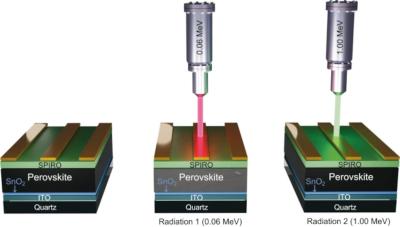Researchers at the University of North Texas, Rochester Institute of Technology, University of North Carolina, National Renewable Energy Laboratory (NREL), University of Oklahoma and NASA Glenn Research Center set out to deepen the understanding of perovskite photovoltaics' ability to recover, or heal, after radiation damage, by studying the effects of radiation based on different energy loss mechanisms from incident protons which induce defects or can promote efficiency recovery.
Dual dose irradiation experiments. Image from Nature Communications
The team designed a dual dose experiment first exposing devices to low-energy protons efficient in creating atomic displacements. Devices were then irradiated with high-energy protons that interact differently. Correlated with modeling, high-energy protons (with increased ionizing energy loss component) effectively anneal the initial radiation damage, and recover the device efficiency, thus directly detailing the different interactions of irradiation.
The scientists related these differences to the energy loss (ionization or non-ionization) using simulation.
Dual dose experiments provided insight into the radiation response of perovskite solar cells and highlight that radiation-matter interactions in soft lattice materials are distinct from conventional semiconductors.
These results present electronic ionization as a unique handle to remedying defects and trap states in perovskites.




